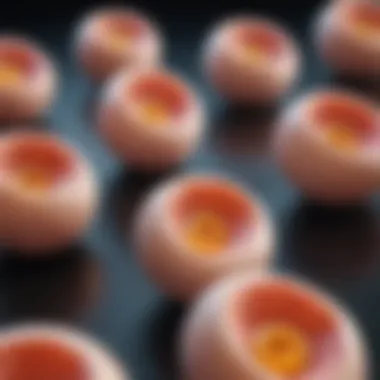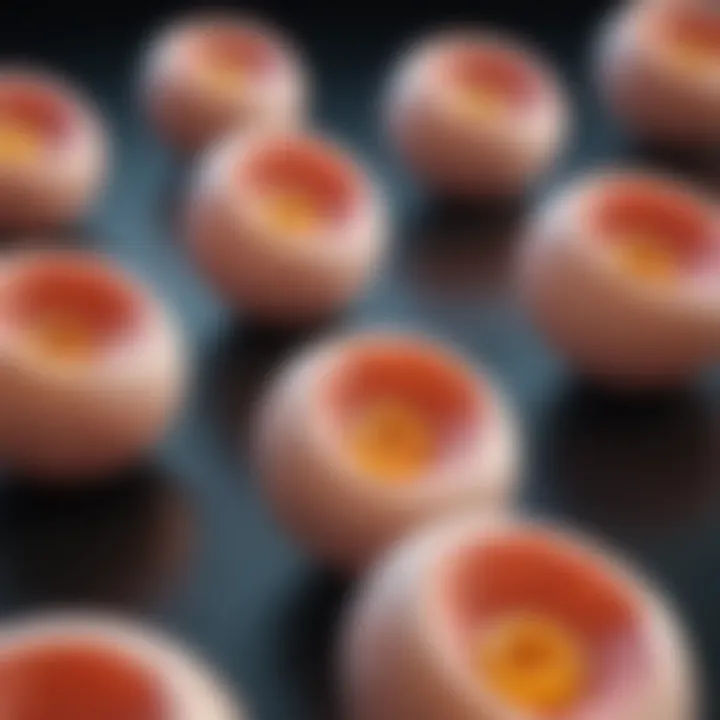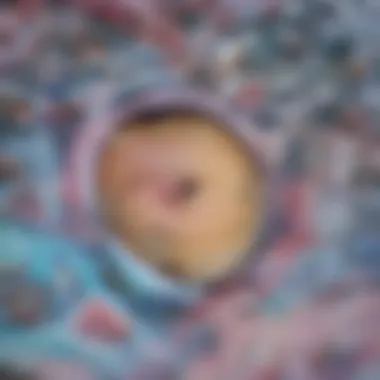Understanding the Complexities of Egg Fertilization


Intro
The fertilization of eggs is a fundamental event in the life cycle of many organisms. It serves as the cornerstone of reproduction, influencing genetic diversity and the evolutionary trajectory of species. The processes involved in fertilization are not merely biological happenstance but orchestrated sequences that underline the complexity of life itself. Understanding the intricacies of this process can enlighten researchers and students about underlying mechanisms that govern reproductive biology.
In this section, we will delve into the research context surrounding egg fertilization. This exploration not only outlines historical studies but also emphasizes the necessity of continuous investigation into these biological functions that maintain ecological balance and contribute to our understanding of life sciences.
Prelude to Fertilization
The fertilization process serves as a cornerstone in the field of reproductive biology. Understanding the intricacies of fertilization not only contributes to basic scientific knowledge but also impacts various practical applications, such as assisted reproductive technologies and conservation efforts. This section will delve into the fundamental aspects of fertilization, elucidating its definition and historical context to set the stage for deeper exploration.
Defining Fertilization
Fertilization refers to the union of two gametes, the sperm from males and the egg from females, leading to the formation of a zygote. This event marks the beginning of a new organism's development. The biological significance of fertilization goes beyond the mere process of merging genetic materials; it initiates a cascade of events that triggers cellular division and differentiation. In humans and many animals, fertilization occurs internally, while in others, such as plants, the process may occur externally.
Understanding the nuances of fertilization helps clarify why it is essential for species continuity, genetic diversity, and evolution. Scientists classify fertilization into two primary types: external and internal. External fertilization is common in aquatic species, where eggs and sperm are released into the water to combine. Internal fertilization, prevalent among terrestrial organisms, provides a protective environment for embryo development.
Historical Perspectives on Fertilization
The journey to obtain our current understanding of fertilization has been replete with discoveries spanning centuries. Early theories regarding reproduction were often speculative and rudimentary. For example, the idea that offspring emerged from a mix of bodily fluids prevailed until the establishment of modern genetics. Notably, in the late 19th century, scientists like Hermann Fol and Walter Flemming conducted key experiments that intensified the quest to unravel fertilization mechanisms.
The introduction of new technologies in microscopy revealed the structure and function of gametes, catalyzing advances in this field. In the 20th century, the advent of vitro fertilization techniques transformed both scientific and societal perspectives on reproduction, pushing boundaries regarding fertility treatments. Understanding these historical developments aids in appreciating contemporary reproductive strategies and challenges.
"Fertilization is not merely a physical event; it is a complex interplay of cellular interactions that govern the future of an organism."
Recognizing the historical context of fertilization enables researchers to frame current discourse on reproductive technologies and ethical considerations surrounding them. As we further explore the layers and mechanisms of this intricate process, the foundational knowledge laid in this section will provide vital insights.
Gametes: The Key Players
Understanding gametes is crucial for grasping the egg fertilization process. Gametes are specialized reproductive cells involved in sexual reproduction. They carry the genetic material from each parent and fuse during fertilization, forming a new organism. This section explores their role in fertilization, highlighting spermatogenesis in males, oogenesis in females, and the structure of these cells.
Spermatogenesis in Males
Spermatogenesis is the process by which sperm cells are produced in the male reproductive system. This complex cycle occurs in the seminiferous tubules of the testes. It starts with spermatogonial stem cells, which divide and undergo several stages of differentiation. Each step is essential for producing mature sperm, capable of fertilization.
The stages include:
- Spermatogonia: These are the initial diploid cells that undergo mitosis to maintain a steady population.
- Primary spermatocytes: These enter meiosis, a reduction division, producing secondary spermatocytes.
- Secondary spermatocytes: They quickly complete meiosis to form spermatids, which are haploid cells.
- Spermatids: These cells undergo further transformation into mature spermatozoa, gaining mobility and the ability to fertilize an egg.
This well-orchestrated process takes approximately 64 to 72 days and is influenced by hormones, including testosterone and follicle-stimulating hormone (FSH). The precise timing of spermatogenesis is vital for maintaining male fertility.
Oogenesis in Females
Oogenesis refers to the formation of egg cells in females, a process inherently different from spermatogenesis. It begins before birth, in the ovaries, where primordial germ cells differentiate into oocytes. Unlike sperm production, which continues throughout life, female egg supply is established during fetal development.
Key stages in oogenesis include:
- Oogonia: These are the initial diploid cells that proliferate through mitosis but stop at prophase of meiosis I, becoming primary oocytes.
- Primary oocytes: These are arrested in meiosis I until ovulation occurs. A female is born with a finite number of these cells.
- Secondary oocytes: At ovulation, the primary oocyte completes meiosis I, resulting in one secondary oocyte and a polar body.
- Fertilization: If fertilization occurs, meiosis II completes, resulting in a zygote and a second polar body.
The female body’s control over oocyte maturation ensures that only a certain number will mature and have the chance for fertilization, adapting to hormonal signals during the menstrual cycle.
Comparative Gamete Structure
The structural differences between sperm and eggs reflect their distinct functions in reproduction. Sperm cells are typically much smaller and motile, designed to travel through the female reproductive tract to reach the egg. In contrast, egg cells are larger, non-motile, and equipped with nutrient reserves.
Key characteristics are:
- Sperm:
- Egg:
- Tail (flagellum): Enables locomotion.
- Head: Contains genetic material and enzymes for penetrating the egg.
- Midpiece: Packed with mitochondria, providing energy.
- Cytoplasm: Rich in nutrients for the early stages of embryo development.
- Zona pellucida: A protective outer layer that plays a role in sperm binding.
- Nucleus: Contains the female genetic material.
Understanding these differences aids in comprehending how fertilization occurs and why each type of gamete is uniquely structured to fulfill its role in reproduction.
In summary, gametes are foundational elements in the fertilization process. Grasping their formation and structure is key to understanding fertilization mechanics and subsequent embryonic development.


The Mechanisms of Fertilization
Understanding the mechanisms of fertilization is essential in comprehending how life initiates at the cellular level. This process encompasses several critical interactions and events that lead to the successful union of sperm and egg. The sperm-egg recognition, penetration of the egg cell membrane, and fertilization triggers in different species are all key elements that contribute significantly to successful fertilization. Recognizing these elements provides insights into reproductive health, conservation efforts, and even advancements in assisted reproductive technologies.
Sperm-Egg Recognition
Sperm-egg recognition is the first step in the fertilization process. This interaction begins when sperm navigate through the female reproductive tract, guided by biochemical signals emitted by the egg. One of the pivotal mechanisms involved is the release of specific proteins from the egg that attract sperm. These proteins are termed chemotactic factors, and they create a gradient that sperm can follow.
The surface of the egg is also equipped with receptor molecules that specifically bind to certain proteins on the sperm surface. This binding is an essential form of recognition and ensures that only the appropriate sperm can engage with the egg. It minimizes the chances of cross-species fertilization, which could lead to unsuccessful fertilization attempts.
Penetration of the Egg Cell Membrane
Once sperm successfully recognize and bind to the egg, they must penetrate the egg cell membrane. This is not a straightforward action. The sperm must first undergo a process called capacitance, which prepares them for successful fusion with the egg. During this process, the sperm alter their membrane properties, allowing them to release enzymes stored in their acrosome. These enzymes facilitate the breakdown of the protective layers surrounding the egg, such as the zona pellucida.
After the zona pellucida is compromised, the sperm can then interact closely with the egg's plasma membrane. This leads to the fusion of their membranes, resulting in the entry of sperm genetic material into the egg. The event prompts the egg to undergo several changes to prevent other sperm from entering, a critical step known as polyspermy prevention.
Fertilization Triggers in Different Species
The mechanisms of fertilization can vary significantly among different species. For example, in aquatic environments, fertilization often occurs externally; eggs and sperm are released into the water, allowing natural selection to determine which sperm reaches the egg. Conversely, in terrestrial animals, internal fertilization increases the likelihood of successful fertilization, as it provides a protected environment for gametes.
Research indicates that different triggers for fertilization can be species-specific. For instance, in sea urchins, the release of calcium ions triggers the activation of the egg after sperm entry. In mammals, the entry of sperm creates a rapid electrical change across the egg membrane, which is critical for subsequent cellular events.
The mechanisms of fertilization are not only fascinating but are also integral to understanding reproductive strategies across the continuum of life.
In summary, the mechanisms of fertilization play a crucial role in reproductive biology. From the intricate recognition between sperm and egg to the diverse strategies employed by various species, these processes are fundamental for the continuation of life.
Post-Fertilization Processes
The post-fertilization processes are essential for progressing from a single fertilized egg to a fully developed organism. Understanding these processes provides insights into how embryonic development is initiated and the factors controlling it.
Cleavage and Blastocyst Formation
Cleavage is the first stage following fertilization, where the zygote undergoes a series of rapid cell divisions. This stage is characterized by mitotic divisions that increase cell number without significant growth in size. The primary purpose of cleavage is to convert the single-cell zygote into a multicellular structure called the blastula.
In humans and many other animals, cleavage occurs in specific patterns influenced by the amount of yolk in the egg. These patterns affect the resulting formation of cells. A blastocyst is formed within about five to six days after fertilization. It is a hollow ball of cells that contains an inner cell mass, which will eventually develop into the embryo.
The formation of the blastocyst is a critical milestone as it is during this phase that implantation into the uterine lining occurs in mammals. Without successful implantation, further development cannot continue. The complexity here lies in the precise regulation of cellular communication and the genetic program that directs the differentiation of the inner cell mass into the various tissues of the embryo.
Germ Cell Layers Formation
Following the formation of the blastocyst, the next step involves the development of the three primary germ layers: the ectoderm, mesoderm, and endoderm. Each of these layers has distinct functions and will give rise to different structures in the developing organism.
- The ectoderm forms the skin, hair, and the nervous system.
- The mesoderm develops into muscles, the skeletal system, and circulatory systems.
- The endoderm is responsible for internal organs such as the intestines and lungs.
This germ layer formation through a process known as gastrulation is crucial because it lays the groundwork for organogenesis, the formation of organs, in later embryonic development. The effectiveness of the process relies on a synchronized series of cellular movements and signaling pathways that dictate the fate of each cell. A disruption in this process can lead to developmental anomalies.
"Development after fertilization is a tightly controlled series of events, each critical for successful organism formation."
For further reading on embryonic development, resources like Wikipedia and Britannica provide valuable insights.
Fertilization across Species
Understanding fertilization across species is crucial for many fields, including biology, agriculture, and medicine. This area of study illustrates how diverse organisms have evolved unique mechanisms for fertilization, influenced by their environment and evolutionary history. It raises questions about reproductive strategies, adaptability, and the role of fertilization in the broader context of life.
Fertilization in Plants
Plant fertilization occurs through the transfer of pollen to the ovule, involving two main types: self-fertilization and cross-fertilization. In self-fertilization, a single plant can fertilize its own ovules, which ensures reproduction in isolated environments. Cross-fertilization, however, promotes genetic diversity, as it occurs between different plants. This diversity bolsters a plant's adaptability, offering potential advantages in changing environments.
Fertilization involves multiple steps:
- Pollination: Pollen grains are transferred from the male anther to the female stigma.
- Pollen Germination: Once on the stigma, pollen germinates, forming a pollen tube that grows down the style toward the ovule.
- Fertilization: Two sperm cells travel through the pollen tube. One sperm fertilizes the egg, while the other merges with two polar nuclei, forming triploid tissue, which develops into endosperm to nourish the embryo.
Each of these stages is intricate and critical to the successful reproduction of flowering plants. Differences in fertilization strategies can ultimately affect crop yields and biodiversity.
Fertilization in Animals


Animal fertilization varies significantly across species, with strategies often categorized as internal or external fertilization. Internal fertilization occurs when sperm fertilizes the egg within the female's body, prevalent among mammals, reptiles, and some insects. This method provides protection to the developing embryo and increases the likelihood of survival.
On the other hand, external fertilization takes place outside the body, as seen in many fish and amphibians. In this case, large quantities of eggs and sperm are released into the water, enhancing the odds of successful fertilization. However, it also exposes fertilized eggs to environmental threats.
Factors influencing animal fertilization include:
- Timing: Synchronization of reproductive cycles increases successful fertilization chances.
- Environmental Conditions: Temperature and habitat can significantly impact fertilization success.
- Sexual Selection: Certain species exhibit complex mating rituals that enhance reproduction effectiveness.
Unique Fertilization Strategies
Across species, various unique fertilization strategies have emerged, showcasing nature's adaptability. For instance, some species of sea turtles return to the same beach to lay eggs, while certain frogs can fertilize eggs that are not yet laid.
Another example includes the remarkable case of Pseudomonas aeruginosa, a bacterium that engages in a form of horizontal gene transfer, allowing genetic material exchange among individuals, functioning as a type of fertilization.
These strategies reveal how organisms adapt their reproductive methods to ensure the continuation of their species. Such variations can inform conservation efforts and help improve methods in agriculture and livestock management.
"Understanding fertilization across species provides insight into evolutionary biology and helps advance techniques in artificial reproduction and conservation."
This awareness is vital, fostering deeper insight into the underlying processes of life itself.
Factors Influencing Fertilization
In the realm of egg fertilization, a plethora of factors come into play. These variables can significantly affect the efficiency and outcomes of the fertilization process. Understanding these influences provides crucial insights for researchers and professionals in the life sciences. Two primary areas to consider here are environmental factors and physiological conditions. Both exert direct effects on gamete viability and interactions.
Environmental Factors
Environmental factors create the backdrop against which fertilization occurs. These include temperature, pH levels, and the presence of various chemicals and pollutants.
- Temperature: This is a critical parameter. For instance, in many aquatic organisms, water temperature can influence sperm motility and egg maturation. Too high or too low temperatures may detract from the successful fusion of gametes.
- pH Levels: The acidity or alkalinity of the surrounding environment also plays a vital role. Certain species, particularly marine organisms, exhibit specific pH ranges in which fertilization is optimal. Deviations may inhibit sperm performance or cause egg atresia.
- Chemical Composition: The presence of certain ions and molecules can enhance or hinder fertilization. For example, calcium ions are known to assist in the activation of the egg after sperm penetration, leading to successful fertilization.
It is essential to note that the impact of these environmental factors often varies between species, necessitating further investigation to identify general principles.
"In many instances, environmental factors act as gatekeepers, determining whether the intricate dance of fertilization proceeds successfully."
Physiological Conditions
Physiological conditions encompass the internal state of reproductive organisms. Factors such as hormonal levels, gamete health, and mating behaviors are crucial considerations here.
- Hormonal Influence: Hormones regulate gamete production and quality. For example, in mammals, hormones like estrogen and progesterone play significant roles in preparing the female reproductive system for fertilization. An imbalance can lead to complications like infertility.
- Gamete Health: The quality of both sperm and eggs can profoundly affect fertilization. Sperm motility and morphology are essential, while the health of oocytes is critical for successful fertilization and subsequent embryo development. Certain lifestyle factors and age can influence gamete health.
- Mating Behaviors: The behaviors leading to successful mating might differ among species. For instance, some species require specific sequences of courtship behaviors, while others have evolved unique strategies to enhance fertilization success.
By examining these physiological parameters, researchers gain valuable insights into the mechanisms underlying fertilization and reproductive success. Understanding these can empower advancements in reproductive technologies and conservation efforts.
Fertilization and Developmental Biology
Fertilization is a critical step in the life cycle of many organisms, serving as the starting point for development post-conception. This section explores how fertilization impacts developmental biology, emphasizing the biological processes that take place immediately following the union of sperm and egg. Understanding this interconnection is vital for both evolutionary biology and applied sciences, influencing research in fields such as genetics, reproductive health, and developmental disorders.
Different stages in embryonic development are directly influenced by the success and characteristics of fertilization. The mechanisms of fertilization not only allow for genetic diversity but also determine the viability of the resulting zygote. For instance, the maternal factors present at fertilization can dictate cellular behavior and asynchronous development.
Role of Fertilization in Development
Fertilization launches a cascade of events essential for successful development. Once the sperm penetrates the egg, several immediate steps occur:
- Activation of the Egg: This is one of the first events, where the zygote undergoes metabolic changes. It readies the egg for further developmental stages.
- Gene Expression: Activation also leads to a wave of gene transcription. Early developmental processes critically depend on this transcription, effectively setting the stage for embryonic growth.
- Cell Division: Following fertilization, the zygote undergoes cleavage, where it divides multiple times, creating a multicellular organism.
Additionally, fertilization is essential in establishing ploidy—the number of sets of chromosomes in a cell. For example, the fusion of a haploid sperm and a haploid egg results in a diploid zygote, a crucial aspect for normal development. Disruptions in this process can lead to severe developmental anomalies and even miscarriage.
Genomic Implications
Fertilization not only brings together genetic material from both parents but also creates a unique genetic blueprint for the new organism. The implications of this genetic amalgamation are profound. Genomic imprinting, where genes are expressed in a parent-of-origin manner, plays a significant role:
- Genetic Variability: The mixing of genes contributes to the genetic diversity of a population, which is vital for evolution.
- Hereditary Traits: Diseases and traits passed down through generations can manifest due to the genetic material combined during fertilization.
- Epigenetics: Environmental factors can influence gene expression through modifications that occur before and after fertilization.
Assisted Reproductive Technologies
Assisted reproductive technologies (ART) have revolutionized the field of reproductive health. These methods address infertility and allow individuals and couples to conceive when traditional methods fail. ART involves the manipulation of eggs, sperm, and embryos to enhance the chances of achieving a successful pregnancy. With increasing global infertility rates, these techniques are becoming more vital not only for personal family planning but also in terms of public health considerations.


The significance of ART lies in its ability to provide options to those facing reproductive challenges. From couples experiencing difficulties due to health conditions to single individuals or same-sex couples wishing to conceive, these technologies cater to a diverse range of needs. The increasing accessibility of ART has noteworthy implications for family structures and reproductive autonomy.
Benefits of assisted reproductive technologies include:
- Increased Success Rates: Many ART techniques demonstrate higher success rates compared to natural conception, particularly for individuals with specific fertility issues.
- Genetic Screening: Techniques such as preimplantation genetic testing allow for the identification of genetic disorders before implantation, reducing the risks of hereditary conditions in offspring.
- Control Over Reproductive Timing: ART allow individuals to delay conception until they are ready, thus addressing personal and professional goals without the pressure of natural fertility declines.
- Diversity of Techniques: Different methods, including in vitro fertilization (IVF) and artificial insemination, enable a broad range of approaches tailored to individual circumstances.
However, there are also important considerations to keep in mind. Ethical implications surrounding ART, including the manipulation of genetic material and the potential commodification of human reproduction, prompt ongoing debate within scientific, medical, and public domains. Accessibility and affordability of these treatments are crucial issues, as they can be prohibitively expensive and may not be covered by insurance.
"Assisted reproductive technologies challenge traditional notions of family and parenthood, opening new avenues but also raising complex ethical questions."
In Vitro Fertilization Techniques
In vitro fertilization (IVF) is perhaps the most recognized form of ART. The process involves retrieving eggs from a woman's ovaries and fertilizing them with sperm in a laboratory setting. Once fertilized, the embryos are monitored for development before being transferred back into the woman’s uterus.
The IVF process typically includes several key steps:
- Ovarian Stimulation: Hormonal medications are administered to stimulate the ovaries, leading to the production of multiple eggs.
- Egg Retrieval: A minor surgical procedure is performed to collect the eggs from the ovaries.
- Fertilization: The eggs are combined with sperm in a petri dish or through intracytoplasmic sperm injection (ICSI), where a single sperm is injected directly into an egg.
- Embryo Culture: Fertilized eggs develop into embryos for a few days in a controlled environment.
- Embryo Transfer: One or more healthy embryos are transferred into the uterus for potential implantation.
IVF offers several advantages, including the ability to work around certain infertility issues, such as uterine or fallopian tube factors. However, it is important to note that success rates can vary based on age, health conditions, and other factors.
Artificial Insemination Methods
Artificial insemination (AI) is another critical technique under the umbrella of ART. This process involves directly placing sperm into a woman's reproductive system to facilitate fertilization. AI may be preferred for couples with specific infertility diagnoses, or for individuals using donor sperm.
The two main types of artificial insemination are:
- Intrauterine Insemination (IUI): Sperm is placed directly into the uterus through a thin catheter, increasing the chances of sperm reaching the egg.
- Intracervical Insemination (ICI): Sperm is deposited near the cervix, relying on the body's natural mechanisms for sperm transport.
AI is generally less invasive and less expensive than IVF, making it a favorable option for many. It can be used in various scenarios, such as couples with unexplained infertility or single mothers seeking to conceive. While the effectiveness is generally lower than that of IVF, it can still offer a viable path to parenthood.
In summary, assisted reproductive technologies such as IVF and artificial insemination provide powerful means for individuals and couples striving to conceive. Understanding these methods enhances awareness of reproductive options and may inform decisions about personal health and family planning.
Ethical Considerations in Fertilization
The ethical dimension of fertilization is a crucial aspect in the ongoing discourse surrounding reproductive technologies. As science advances, the capabilities to manipulate genetic material and influence reproductive processes have expanded significantly. Ethical considerations in this realm encompass various elements that span from genetic manipulation ethics to broader implications on societal structures and individual rights.
Understanding the ethical considerations enhances our approach to responsible science. Dilemmas arise regarding who controls reproductive choices and the long-term impacts that such choices can have on individuals and society as a whole. Such considerations are not merely academic; they directly affect policies and practices in reproductive health sectors.
Ethics of Genetic Manipulation
The ethics surrounding genetic manipulation involve significant scrutiny. Techniques such as CRISPR-Cas9 allow for precise editing of genomic sequences. While these advancements hold potential for eradicating genetic disorders, they also raise essential questions about consent, safety, and the potential for unintended consequences.
- Informed Consent: In the context of genetic manipulation, is it possible to fully inform individuals about the potential consequences of altering their genetic material? How can we ensure they comprehend the long-term effects?
- Designer Babies: As technologies progress, there is growing concern about the potential creation of "designer babies," where parents might choose traits for physical appearance, intelligence, or even athletic ability. This leads to dialogues on equality and accessibility in reproductive technologies, potentially reinforcing societal inequalities.
- Biodiversity Impact: Altering genetic material also risks compromising biodiversity. Changing traits in one species may have unforeseen effects on entire ecosystems, thus painting a much larger picture when contemplating genetic modifications.
"The ethical implications of genetic manipulation require a balance between scientific advancement and social responsibility. The moral compass must guide progress."
Reproductive Rights and Societal Impacts
Reproductive rights are a fundamental part of personal freedom and autonomy. There is a constant tension between individual rights to reproduce and societal interests in population control and genetic quality. Ethical considerations in this scope are multi-faceted.
- Personal Autonomy: Individuals should have the freedom to make choices regarding their reproductive health. Restricting access can lead to violations of personal rights and has ramifications on personal and public health.
- Access to Technologies: Unequal access to assisted reproductive technologies can exacerbate social injustices. Policies should ensure that these technologies are available to all, regardless of socioeconomic background.
- Societal Norms: The societal perception of reproductive technologies influences public policies. Gender roles, cultural beliefs, and economic conditions shape the discourse around fertilization and reproduction. Ethical considerations must take these factors into account to foster a society that respects individual choices while ensuring collective well-being.
Epilogue
The conclusion serves as a vital component in understanding the egg fertilization process. It provides a synthesis of the various elements discussed throughout the article, connecting complex biological interactions with their practical implications. From the initial gamete formation to the intricate mechanisms that govern fertilization, each stage plays a role in ensuring the continuation of life across species.
Recognizing the importance of fertilization in both plant and animal life emphasizes its foundational role in developmental biology. Through an examination of this process, we can appreciate not only its biological necessity but also its broader implications for genetics and evolution. Key insights gained from this exploration reveal how understanding fertilization can influence advancements in areas such as reproductive health and assisted technologies.
Moreover, the ethical considerations surrounding fertilization and genetic manipulation call for thoughtful dialogue among scientists, ethicists, and the public. As we navigate the complexities of reproductive rights and societal impacts, the conclusion brings awareness to the responsibilities that accompany such profound scientific knowledge.
It's crucial to see fertilization not merely as a biological event, but as a multifaceted process that intertwines science, ethics, and the future of species.
Summarizing Key Insights
A comprehensive understanding of the egg fertilization process reveals several critical points:
- Gametes are essential: The role of sperm and eggs as key players highlights the significance of gamete quality and viability in successful fertilization.
- Mechanisms of interaction: Sperm-egg recognition and interaction eloquently demonstrate how complex biochemical signals govern fertility.
- Post-fertilization events: Recognizing the stages after fertilization, like cleavage and blastocyst formation, shows how early development is influenced by the initial fertilization event.
- Species variability: Observations of fertilization across diverse species underscore an evolutionary perspective on reproductive strategies.
- Environmental influences: Understanding how external factors can impact fertilization helps in developing approaches to improve reproductive health.
Future Directions in Fertilization Research
The field of fertilization research is constantly evolving, with several future directions worth noting:
- Advancements in Assisted Reproductive Technologies: Techniques like in vitro fertilization and genetic screening are pivotal for addressing infertility issues. Improved methods could enhance success rates and reduce ethical dilemmas.
- Genetic Editing Implications: Tools such as CRISPR offer exciting prospects for manipulating genetic material at the fertilization stage. However, this also raises ethical concerns that require careful consideration.
- Environmental Impact Studies: Investigating how climate change and environmental degradation affect gamete viability and fertilization success is an urgent need.
- Interdisciplinary Approaches: Collaboration among developmental biologists, geneticists, ecologists, and ethicists can lead to a more nuanced understanding of fertilization.
- Public Engagement and Education: It is crucial to communicate findings to the public regarding the significance and ethical implications of fertilization research. Enhancing awareness can cultivate informed discussions around fertility and genetic technology.



